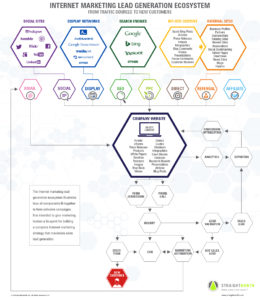Crafting and executing an Internet marketing lead generation campaign is far more complex than meets the eye, so to help marketers see more clearly, we at Straight North, an SEO Chicago firm, created the “Internet Marketing Lead Generation Ecosystem” infographic. Understanding how all pieces of a campaign fit together makes the difference between a campaign that produces a steady flow of sales leads and one that sputters and ultimately fizzles out.
In addition to not seeing how all of the pieces fit together, marketers sometimes are handicapped by chasing the latest “shiny object.” For a long time, social media was the hot thing, and now we hear about local optimization, mobile marketing, content marketing, post-content marketing, GIFs, big data — there’s really no end to it. But rapid technological advancements combined with online marketing buzz and nonstop chatter easily distract marketers from the fundamentals of successful lead generation marketing. Thus for many marketers, the process-related components seen at the lower section of the infographic may be the most important reminders of all.
For instance, how many marketing campaigns that are viewed by company leadership as being rather sophisticated fail to execute the fundamental task of capturing phone lead data? Quite a few, if truth be told. Google Analytics, the cornerstone of most online marketing lead generation reporting, does not support phone tracking. If a company wants to understand the marketing source of its phone leads, and incorporate phone lead data in its ROI calculations, it must implement phone tracking using other systems. While many tracking options are available, many companies aren’t aware of their existence or lack the expertise to set them up.
Another very common fundamental — lead validation — is overlooked more times than not. Lead validation is a labor-intensive process of listening to recorded phone conversations and reading form submissions generated by Internet marketing campaigns. The purpose of lead validation is to separate true sales leads from other inquiries such as spam, sales solicitations, personal phone calls, etc. On average, 50 percent of website inquiries are something other than sales leads. If lead data is not validated, companies tend to view all inquiries as leads, and as a result, grossly overestimate the effectiveness of their campaigns. Furthermore, if campaign testing is based on inquiry data rather than validated lead data, test results will be skewed, and rather than optimizing campaigns, campaign managers may make them worse. For instance, a keyword that generates hundreds of inquiries but few leads will be given emphasis simply because the distinction is invisible to the campaign manager.
Website Content Matters … a Lot
While marketers easily become enamored with the latest and greatest online marketing techniques, sales prospects continue to be motivated by the same thingthey always have been: “What’s in it for me?”As the infographic shows, company websites have a lot of content options to answer that simple question. But how many companies use the best content options, the ones that drive conversions?
We made the “company website” hexagon large and showed content options because the content matters — a lot. However, because creating certain types of highly effective content such as video and e-books is expensive and laborious, companies avoid it. As a result, their websites contain lackluster text accompanied by lifeless stock photography — content that is hard to read, hard to scan, hard to get excited about, and that ultimately fails to address the question, “What’s in it for me?”
When companies fail to upgrade their content to match the sophistication of their Internet marketing campaigns, they set themselves up for failure. SEO is a great example of this campaign-content disconnect. SEO campaigns are designed to drive qualified traffic to the company website. An effectively managed campaign will produce steadily increasing organic traffic year over year. However, if an SEO campaign doubles, triples, quadruples or quintuples traffic but visitors don’t convert, what value does the SEO campaign have?
From a revenue standpoint, the answer is no value. An SEO campaign can never be better than the conversion power of the content on the website. Companies that invest heavily in SEO but resist investing in top-quality content are undermining themselves — and our guess isthis happens mainly because companies don’t see how these two things are connected. A cursory look at the ecosystem infographic will solve that problem.
Picking the Right Campaigns
Looking at the top of the infographic, marketers may find a lot of information upon which to reflect. For instance, it’s one thing to invest in SEO because it has proved superior to alternate methods of lead generation, and another thing entirely to invest in SEO “just because.”
And, if truth be told, companies sometimes do invest in a certain type of marketing “just because.” Nowhere has this been more evident than with social media. When companies see every competitor jumping on Facebook, they decide they must be on Facebook, too. The same thing happens with SEO and email marketing — perhaps to a lesser extent, but it still is a debilitating “monkey-see-monkey-do” syndrome.
Smart online marketers continually assess their options objectively, using cold calculations and careful testing. While it is a mistake to put all of one’s eggs in one basket (such as email marketing) and never try anything else, it also is a mistake to overextend the budget and try to do everything. Instead, track lead production of core campaigns as granularly as possible, and test different campaigns systematically. If something new proves better than something in place, the long-term improvement in lead generation can be astounding.
The challenge, of course, is selecting which online marketing methods to test, how to structure the test and how long to run the test before reaching a conclusion. In our experience, companies often give up too soon. An email marketing or SEO campaign takes several months or even a year or more to produce meaningful results. Running an email or SEO test for six months is not long enough … letting them run for five years is much too long. Without doubt, marketers who spend a great deal of time and thought in strategizing their online testing will succeed far more quickly and frequently than those who act on impulse. Online lead generation is part art and part science, but even the art needs to be created in the lab!











